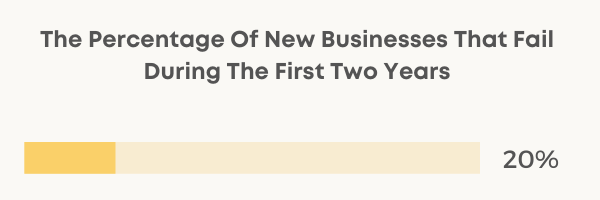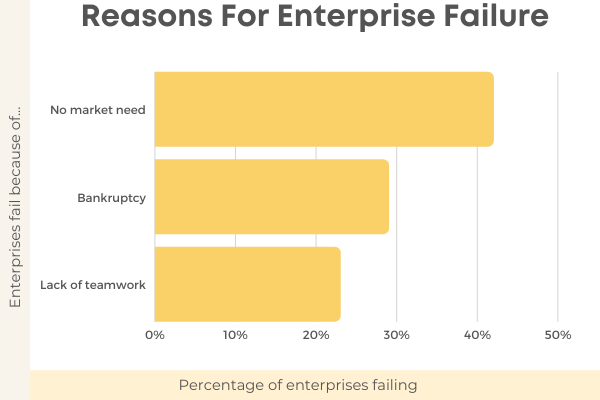How many entrepreneurs fail and how many succeed? How long does it take for a new business to fail or to become very successful?
These are only some of the interesting and rather important questions in the entrepreneurial world. By knowing why entrepreneurs fail, future entrepreneurs can learn a lesson and prepare themselves to see how likely it is that they will succeed.
By learning about the percentage of entrepreneurs that fail and the percentage of successful entrepreneurs, it is easier to prepare for the future.
Statistics/Percentage Of Entrepreneurs That Fail And Succeed (Editor’s Pick)
- 20% of businesses fail in the first two years.
- Due to no market need, 42% of entrepreneurs fail.
- One-quarter of new businesses make it past 15 years.
- Due to poor cash management, eight in 10 businesses fail.
10 Statistics/Percentage Of Successful Entrepreneurs & Entrepreneurs That Fail
1. During the first two years since opening, one in five new businesses fail.
In the United States, 20% of the new businesses fail in the first two years of opening. This percentage of failed entrepreneurs’ data is taken from the U.S. Bureau of Labor Statistics.
Source: U.S. Bureau of Labor Statistics


2. The most successful businesses are started by middle-aged men.
Studies are showing that middle-aged men who have previous experience in the same field they are starting a business are most likely to succeed. This goes against the common opinion that young entrepreneurs are usually the most successful.
Source: MIT Sloan
3. Eight in 10 new businesses are still operating one year into the opening.
According to the Kauffman Indicators of Entrepreneurship, most entrepreneurs are still successful one year into the opening. As a matter of fact, 80% of them still operate after one year.
Source: Kauffman Indicators of Entrepreneurship
4. The survival rate for businesses falls to 50% after the first five years.
While statistics show that the percentage of entrepreneurs that fail after the first year is around 20%, the survival rate falls to 50% after the first five years of business operation.
Source: U.S. Bureau of Labor Statistics
5. The number one reason entrepreneurs (42%) fail is the fact there is no market need.
According to stats from CBIsnights, 42% of entrepreneurs fail because there is no market need for what they have to offer. However, there are many other reasons businesses fail. Around three in 10 (29%) fail because of bankruptcy, while 23% fail as there is a lack of chemistry and teamwork among employees.
Source: CBInsights


6. In the first year, 20% of businesses fail.
Statistics from 2020 show that one in five (20%) businesses fail in the first year of starting. Moreover, around one in three businesses reach 10 years.
Source: BLS
7. Since 1977, the business failure rate has declined by 30%.
In the last 45 years, the rate at which businesses fail has declined by 30%. The reason as to why this happened lies in the fact that entrepreneurs have become smarter and that there is a smaller number of new businesses, according to a professor at Case Western Reserve University, Scott Shane.
Source: Entrepreneur
8. Only one in four new businesses make it past 15 years.
The percentage of successful entrepreneurs 15 years after starting is low. According to the U.S. Bureau of Labor Statistics, only 25% of new businesses are still up and running 15 years later.
Source: U.S. Bureau of Labor Statistics
9. Enterprises with two founders are 30% more likely to be successful.
The success rate of businesses founded by two entrepreneurs is higher. According to Small Business Trends, enterprises with two founders have 30% more odds to be more successful and make more money.
Source: Small Business Trends
10. Because of poor cash management, 82% of businesses fail.
Finances and their management are very important for the success of enterprises. According to Talkroute, 82% of businesses fail due to poor cash management.
Source: Talkroute
Final Verdict
Entrepreneurs fail and succeed due to many different reasons, but some of them do prevail, such as financial problems, no market need, etc. Moreover, entrepreneur age statistics also show that the age of entrepreneurs can play a role in success or failure. These entrepreneur statistics offer great insight into the world of enterprise and shows regularities and irregularities in entrepreneurship.
































Find Us on Socials